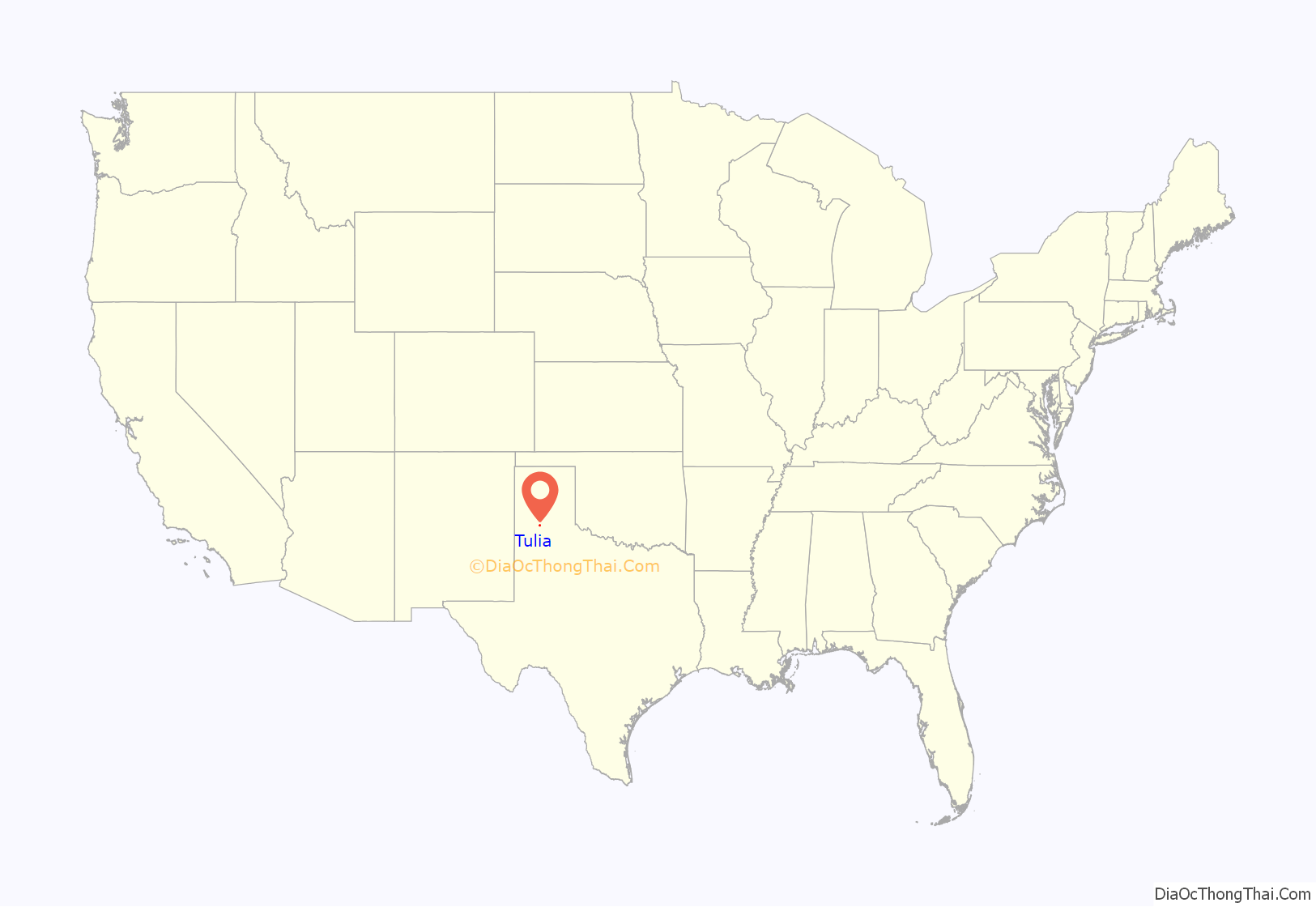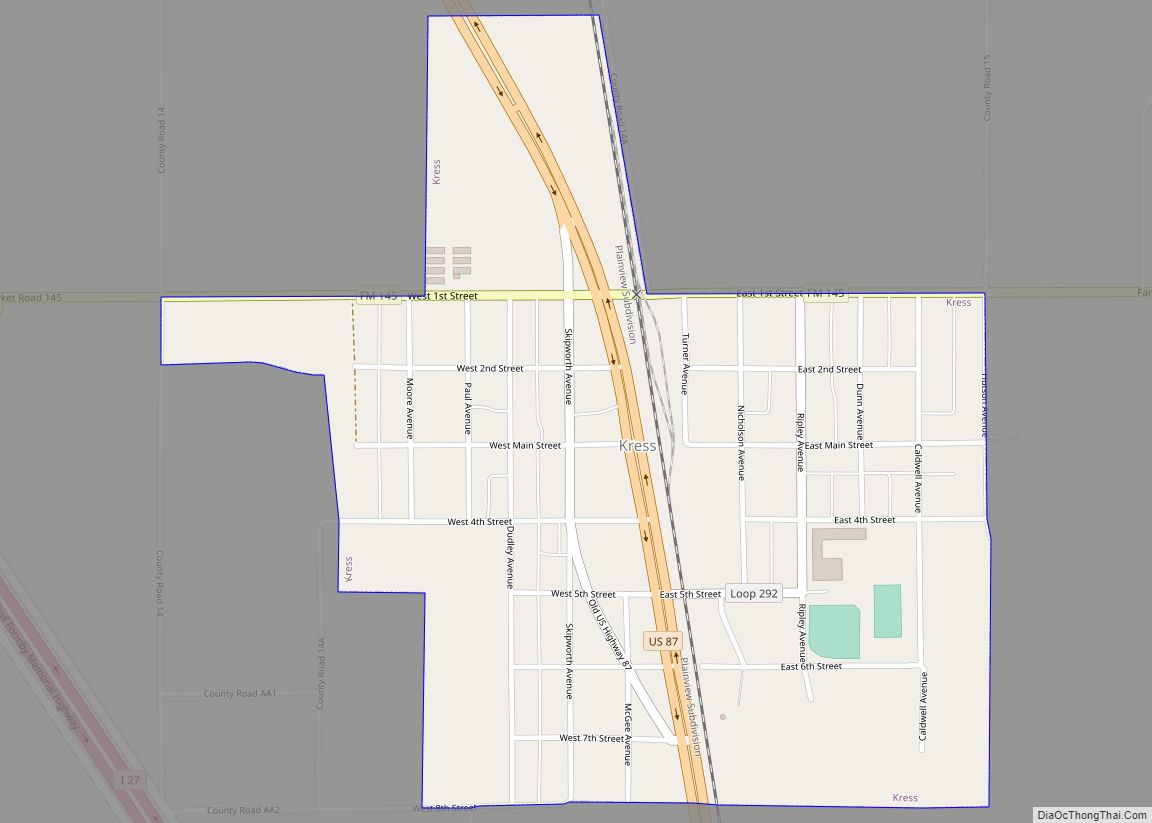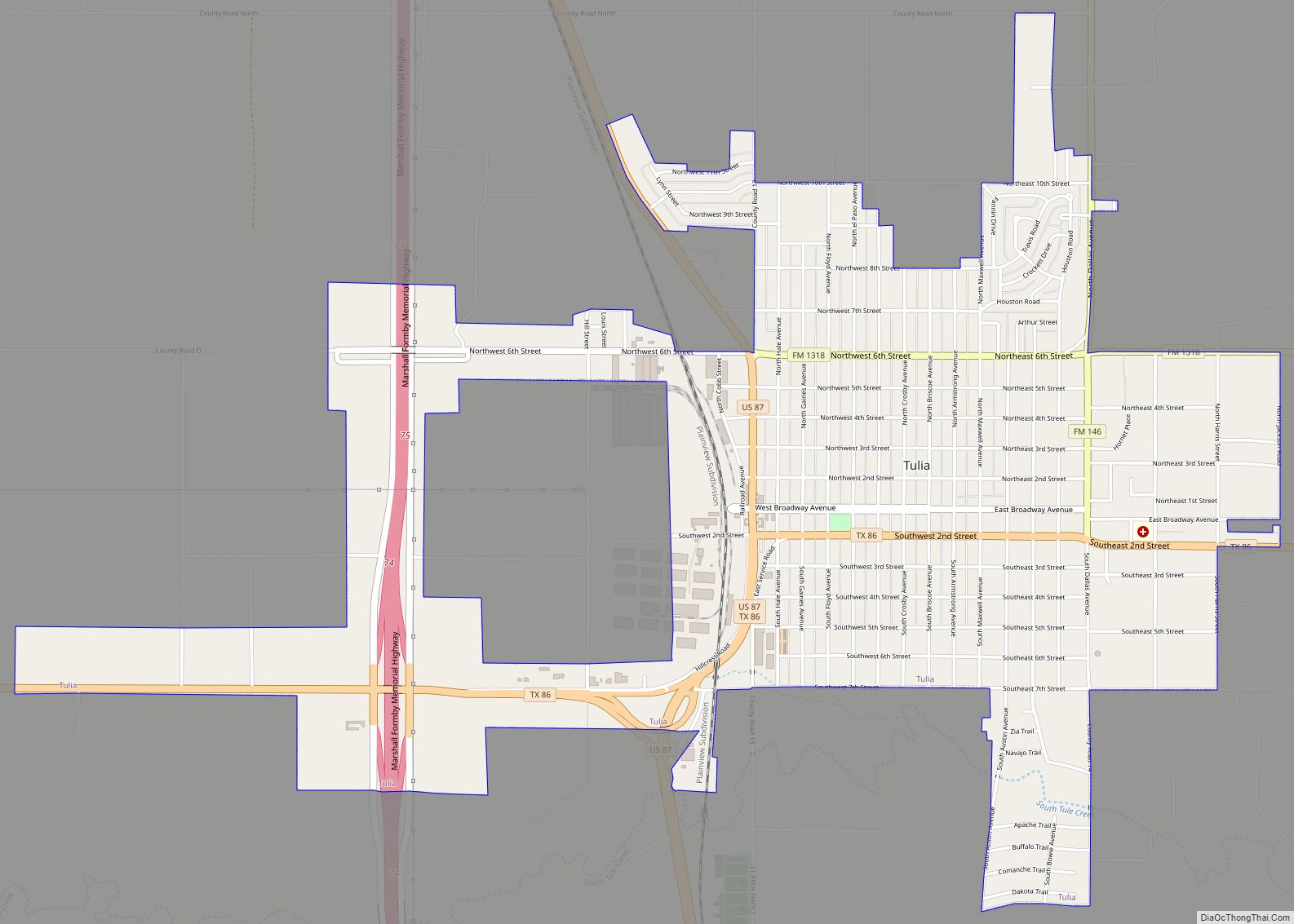Tulia is a city in, and county seat of, Swisher County, Texas, United States. The population was 4,967 at the 2010 census; in the 2018 census estimate, it had fallen to 4,682. The city is at the junction of U.S. Route 87 and Texas State Highway 86, about 2 miles (3 km) east of Interstate 27. Tulia is a center for farming and agribusiness activities.
| Name: | Tulia city |
|---|---|
| LSAD Code: | 25 |
| LSAD Description: | city (suffix) |
| State: | Texas |
| County: | Swisher County |
| Elevation: | 3,484 ft (1,062 m) |
| Total Area: | 3.57 sq mi (9.24 km²) |
| Land Area: | 3.56 sq mi (9.21 km²) |
| Water Area: | 0.01 sq mi (0.03 km²) |
| Total Population: | 4,967 |
| Population Density: | 1,308.69/sq mi (505.23/km²) |
| ZIP code: | 79088 |
| Area code: | 806 |
| FIPS code: | 4873868 |
| GNISfeature ID: | 1370199 |
| Website: | www.tuliatexas.org |
Online Interactive Map
Click on ![]() to view map in "full screen" mode.
to view map in "full screen" mode.
Tulia location map. Where is Tulia city?
History
Its site was originally on the acreage of the Tule Ranch division of the JA Ranch. In 1887, a post office was established in James A. Parrish’s dugout on Middle Tule Draw, 9 miles (14 km) west of what is now the site of Tulia. Evidently, the name Tule, after the nearby creek, had been selected for this post office, but at some point a clerk’s error changed the name to Tulia. By 1900, Tulia was prospering as a stopping point for freight-wagon traffic en route to the railheads of Colorado City and Amarillo. A booming new era began with the extension of the Santa Fe line to Tulia in December 1906; with it came more settlers. In the mid-1980s, local industrial plants manufactured products such as clothing and farm implements, and four large cattle-feeding enterprises were nearby.
1999 drug arrest scandal
Tulia gained notoriety following a drug sting in July 1999 that rounded up 46 people, 39 of whom were innocent African Americans. The remaining detainees were Whites known to have ties within the Black community, and in fact lived in the “Black” part of town. Nearly one-third of Tulia’s Black males were arrested, about 15% of the town’s Black population. All charges were based on the word of undercover officer Tom Coleman, a so-called “gypsy cop” who made his living traveling through impoverished rural Texas offering to work undercover cheaply for short periods of time for underfunded police departments. Coleman claimed to have made over 100 drug buys in the small town. He never recorded any of the sales, but claimed to have written painstaking notes on his leg under his shorts and upper arm under his shirt sleeve when nobody was looking.
During the roundup, no large sums of money, illegal drugs, drug paraphernalia, nor illegal weapons were found. The accused drug dealers showed no signs of having any income associated with selling drugs. The drugs Coleman claimed to have bought from the accused did not have the fingerprints of the accused on them or their baggies. No independent witnesses could corroborate Coleman’s claims. In his testimony, Coleman gave inaccurate descriptions of the “dealers” from whom he had allegedly bought cocaine. One suspect had his charges dropped when he was able to prove he had been at work during the times he had supposedly sold Coleman cocaine. Another produced bank and phone records indicating she was in Oklahoma City, Oklahoma, at the time of her alleged crime. Many of the accused, however, seeing the long sentences dealt by all-White juries in earlier cases, pled guilty in return for lighter sentences, despite their proclaimed innocence. The remaining defendants were convicted solely on the basis of Coleman’s testimony. The Texas Department of Public Safety and Texas attorney general John Cornyn awarded “Lawman of the Year” to Coleman.
Amarillo civil rights attorney Jeff Blackburn began investigating the Tulia defendants’ cases, along with civil rights organizations and a handful of attorneys from firms around the country. Eventually, the case became a cause célèbre, and money was raised to legally challenge the cases. Many had already served several years in prison before this process gained momentum. By 2004, Blackburn and his team had freed most of the “Tulia 46” and a $6,000,000 collective settlement was reached to avoid further litigation in civil court. Local authorities remain defiant, promising their town will not become a “slot machine” in the face of a new lawsuit stemming from an alleged incident of police brutality during the sweep.
In 2005, Coleman was convicted of perjury and sentenced to 10 years’ probation and a $7,500 fine.
Federal laws titled after Tulia have twice been introduced in the United States Congress, but not enacted, to increase the evidentiary standard required to convict a person for a drug offense and to require screening of law enforcement officers or others acting under color of law participating in drug task forces.
Tulia Road Map
Tulia city Satellite Map
Geography
Tulia is located at 34°32′09″N 101°45′31″W / 34.5358942°N 101.7585159°W / 34.5358942; -101.7585159. It is located 46 miles (74 km) south of Amarillo in the Texas Panhandle. According to the United States Census Bureau, the city has a total area of 3.5 square miles (9.1 km), all of it land.
Climate
According to the Köppen climate classification system, Tulia has a semiarid climate, BSk on climate maps.
Record low
Tulia holds the record for the lowest temperature in Texas, −23 °F (−31 °C), set during the Great Blizzard of 1899. The temperature was matched by Seminole, Texas, in 1933.
See also
Map of Texas State and its subdivision:- Anderson
- Andrews
- Angelina
- Aransas
- Archer
- Armstrong
- Atascosa
- Austin
- Bailey
- Bandera
- Bastrop
- Baylor
- Bee
- Bell
- Bexar
- Blanco
- Borden
- Bosque
- Bowie
- Brazoria
- Brazos
- Brewster
- Briscoe
- Brooks
- Brown
- Burleson
- Burnet
- Caldwell
- Calhoun
- Callahan
- Cameron
- Camp
- Carson
- Cass
- Castro
- Chambers
- Cherokee
- Childress
- Clay
- Cochran
- Coke
- Coleman
- Collin
- Collingsworth
- Colorado
- Comal
- Comanche
- Concho
- Cooke
- Coryell
- Cottle
- Crane
- Crockett
- Crosby
- Culberson
- Dallam
- Dallas
- Dawson
- Deaf Smith
- Delta
- Denton
- Dewitt
- Dickens
- Dimmit
- Donley
- Duval
- Eastland
- Ector
- Edwards
- El Paso
- Ellis
- Erath
- Falls
- Fannin
- Fayette
- Fisher
- Floyd
- Foard
- Fort Bend
- Franklin
- Freestone
- Frio
- Gaines
- Galveston
- Garza
- Gillespie
- Glasscock
- Goliad
- Gonzales
- Gray
- Grayson
- Gregg
- Grimes
- Guadalupe
- Hale
- Hall
- Hamilton
- Hansford
- Hardeman
- Hardin
- Harris
- Harrison
- Hartley
- Haskell
- Hays
- Hemphill
- Henderson
- Hidalgo
- Hill
- Hockley
- Hood
- Hopkins
- Houston
- Howard
- Hudspeth
- Hunt
- Hutchinson
- Irion
- Jack
- Jackson
- Jasper
- Jeff Davis
- Jefferson
- Jim Hogg
- Jim Wells
- Johnson
- Jones
- Karnes
- Kaufman
- Kendall
- Kenedy
- Kent
- Kerr
- Kimble
- King
- Kinney
- Kleberg
- Knox
- La Salle
- Lamar
- Lamb
- Lampasas
- Lavaca
- Lee
- Leon
- Liberty
- Limestone
- Lipscomb
- Live Oak
- Llano
- Loving
- Lubbock
- Lynn
- Madison
- Marion
- Martin
- Mason
- Matagorda
- Maverick
- McCulloch
- McLennan
- McMullen
- Medina
- Menard
- Midland
- Milam
- Mills
- Mitchell
- Montague
- Montgomery
- Moore
- Morris
- Motley
- Nacogdoches
- Navarro
- Newton
- Nolan
- Nueces
- Ochiltree
- Oldham
- Orange
- Palo Pinto
- Panola
- Parker
- Parmer
- Pecos
- Polk
- Potter
- Presidio
- Rains
- Randall
- Reagan
- Real
- Red River
- Reeves
- Refugio
- Roberts
- Robertson
- Rockwall
- Runnels
- Rusk
- Sabine
- San Augustine
- San Jacinto
- San Patricio
- San Saba
- Schleicher
- Scurry
- Shackelford
- Shelby
- Sherman
- Smith
- Somervell
- Starr
- Stephens
- Sterling
- Stonewall
- Sutton
- Swisher
- Tarrant
- Taylor
- Terrell
- Terry
- Throckmorton
- Titus
- Tom Green
- Travis
- Trinity
- Tyler
- Upshur
- Upton
- Uvalde
- Val Verde
- Van Zandt
- Victoria
- Walker
- Waller
- Ward
- Washington
- Webb
- Wharton
- Wheeler
- Wichita
- Wilbarger
- Willacy
- Williamson
- Wilson
- Winkler
- Wise
- Wood
- Yoakum
- Young
- Zapata
- Zavala
- Alabama
- Alaska
- Arizona
- Arkansas
- California
- Colorado
- Connecticut
- Delaware
- District of Columbia
- Florida
- Georgia
- Hawaii
- Idaho
- Illinois
- Indiana
- Iowa
- Kansas
- Kentucky
- Louisiana
- Maine
- Maryland
- Massachusetts
- Michigan
- Minnesota
- Mississippi
- Missouri
- Montana
- Nebraska
- Nevada
- New Hampshire
- New Jersey
- New Mexico
- New York
- North Carolina
- North Dakota
- Ohio
- Oklahoma
- Oregon
- Pennsylvania
- Rhode Island
- South Carolina
- South Dakota
- Tennessee
- Texas
- Utah
- Vermont
- Virginia
- Washington
- West Virginia
- Wisconsin
- Wyoming







